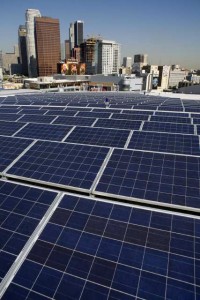 As part of Trump’s effort to restore U.S. manufacturing (and probably undercut clean energy rivals to his fossil fuel supporters), he instituted in January 30% tariffs on imported solar photovoltaic modules and cells, declining 5% per year to 15% in 2022.
As part of Trump’s effort to restore U.S. manufacturing (and probably undercut clean energy rivals to his fossil fuel supporters), he instituted in January 30% tariffs on imported solar photovoltaic modules and cells, declining 5% per year to 15% in 2022.
At the time, the solar manufacturing industry cried doom-and-gloom about supposedly massive job layoffs and lost solar panel deployment. For example, Solar Energy Industries Association president Abigail Hopper claimed the tariffs would lead to a “crisis” for the industry and potentially cost 260,000 American jobs.
But so far the evidence is underwhelming about the impacts to the industry. As Utility Dive reported:
But while the tariffs are having some negative impacts, the industry and its customers now say their concerns were exaggerated. This is largely because solar installed costs have fallen so far and so fast, especially for utility-scale solar, that the relatively small increase in the module price due to the tariffs is having less of an impact than anticipated.
The examples of specific companies are particularly illuminating:
Recurrent Energy, a leading utility-scale solar developer which opposed the tariffs, has reported no project changes. First Solar, an equally important utility-scale scale developer which endorsed the tariffs, has also announced no major changes.
National residential installer Sunnova and California residential installer Spice Solar both told Utility Dive the falling installed cost has offset the tariffs.
Meanwhile, solar installers are working on legislation to repeal the tariffs, introduced recently by Rep. Jacky Rosen (D-NV).
Tariffs on solar certainly aren’t helpful to the industry. But the reaction so far in the first and most severe year of the tariffs is certainly encouraging. Based on what we’ve seen, it sounds like even Trump’s hostility to clean energy isn’t enough to slow the pace of deployment.


